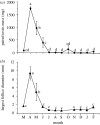Sex differences in the response to environmental cues regulating seasonal reproduction in birds
- PMID: 17638693
- PMCID: PMC2606748
- DOI: 10.1098/rstb.2007.2137
Sex differences in the response to environmental cues regulating seasonal reproduction in birds
Abstract
Although it is axiomatic that males and females differ in relation to many aspects of reproduction related to physiology, morphology and behaviour, relatively little is known about possible sex differences in the response to cues from the environment that control the timing of seasonal breeding. This review concerns the environmental regulation of seasonal reproduction in birds and how this process might differ between males and females. From an evolutionary perspective, the sexes can be expected to differ in the cues they use to time reproduction. Female reproductive fitness typically varies more as a function of fecundity selection, while male reproductive fitness varies more as a function sexual selection. Consequently, variation in the precision of the timing of egg laying is likely to have more serious fitness consequences for females than for males, while variation in the timing of recrudescence of the male testes and accompanying territory establishment and courtship are likely to have more serious fitness consequences for males. From the proximate perspective, sex differences in the control of reproduction could be regulated via the response to photoperiod or in the relative importance and action of supplementary factors (such as temperature, food supply, nesting sites and behavioural interactions) that adjust the timing of reproduction so that it is in step with local conditions. For example, there is clear evidence in several temperate zone avian species that females require both supplementary factors and long photoperiods in order for follicles to develop, while males can attain full gonadal size based on photoperiodic stimulation alone. The neuroendocrine basis of these sex differences is not well understood, though there are many candidate mechanisms in the brain as well as throughout the entire hypothalamo-pituitary-gonadal axis that might be important.
Figures


References
-
- Andersson M. Princeton University Press; Princeton, NJ: 1994. Sexual selection.
-
- Baker J. The evolution of breeding seasons. In: DeBeer G.B, editor. Evolution: essays on aspects of evolutionary biology. Clarendon Press; Oxford, UK: 1938. pp. 161–177.
-
- Ball G.F. The neural integration of environmental information by seasonally breeding birds. Am. Zool. 1993;33:185–199.
-
- Ball G.F, Balthazart J. Neuroendocrine mechanisms regulating reproductive cycles and reproductive behavior in birds. In: Pfaff D.W, Arnold A.P, Etgen A.M, Fahrbach S.E, Rubin R.T, editors. Hormones, brain and behavior. vol. 2. Academic Press; San Diego, CA: 2002. pp. 649–798.
-
- Ball G.F, Bentley G.E. Neuroendocrine mechanisms mediating the photoperiodic and social regulation of seasonal reproduction in birds. In: Wallen K, Schneider J.E, editors. Reproduction in context: social and environmental influences on reproductive physiology and behavior. MIT Press; Cambridge, MA: 2000. pp. 129–158.
Publication types
MeSH terms
Grants and funding
LinkOut - more resources
Full Text Sources
